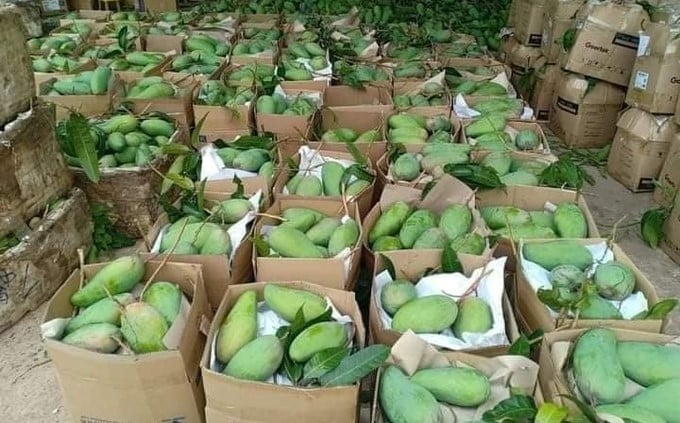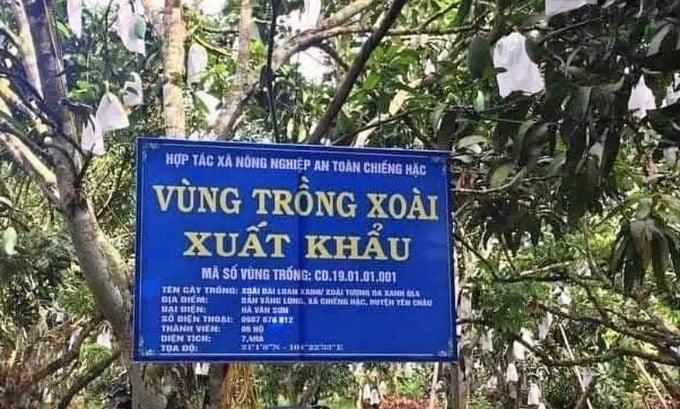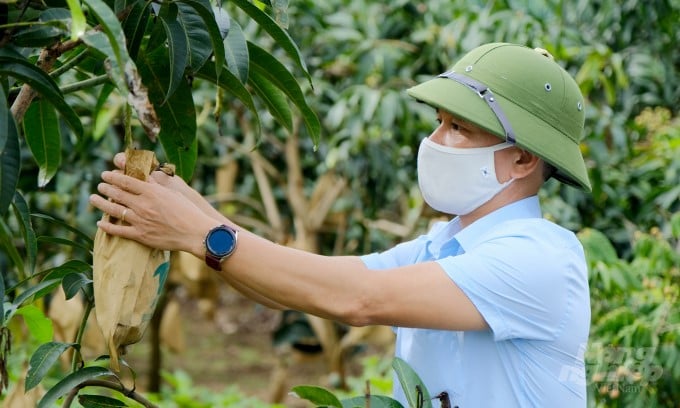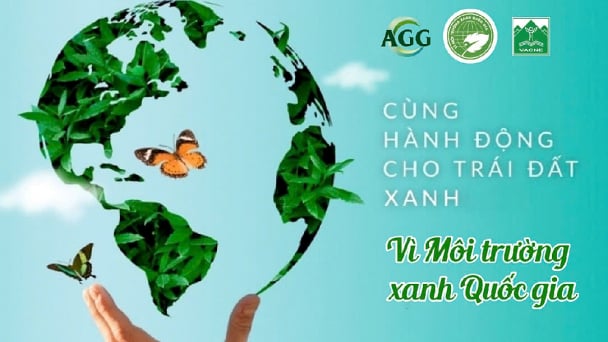May 19, 2025 | 03:52 GMT +7
May 19, 2025 | 03:52 GMT +7
Hotline: 0913.378.918
May 19, 2025 | 03:52 GMT +7
Hotline: 0913.378.918

Yen Chau round mango brand has gradually been affirmed in the market. Photo: Duc Binh.
Normally, domestically consumed mangoes weigh about 0.3–0.5 kg/fruit. However, in the round mango capital of Son La, Yen Chau district, mangoes as big as thermoses are not rare. Thanks to the good variety and suitable weather and soil, mangoes grown in Yen Chau produce very large fruits. The average weight reaches 0.6–1 kg/fruit, and many fruits weigh up to 1.5–1.7 kg, so local people often call this mango variety the elephant mango.
Mr. Ha Van Son, Director of Chieng Hac Safe Agricultural Cooperative, said that in 2024, on an area of 2 hectares, the facility harvested 37 tons of mangoes, of which 60% of the output was exported to China with a selling price of VND 8,000–9,000/kg. Exported mangoes meet VietGAP standards, have a beautiful design and a uniform weight of 0.6–0.9 kg/fruit, and are usually harvested when the skin is still green and golden after about a week.
After each harvest crop, caring for and managing the canopy of mango trees is an important step to ensure productivity for the next crop. From July to November, after pruning branches to create a canopy, the tree is watered 1–2 times, and then no additional watering is needed to help the tree recover. Besides, Mr. Son and cooperative members focus on pruning, such as removing diseased, weak branches and branches in the canopy, to create ventilation, helping the tree grow strongly.
Particularly when the tree has just sprouted young buds, farmers often select very carefully, only keeping 2–3 healthy buds that are evenly distributed in all directions. When leaves are old, diseased branches continue to be pruned, ready for the next flowering stage.
Promoting the export of fruits is a major policy of Son La province. To ensure product quality, Mr. Son has actively participated in training sessions of the Department of Agriculture and Rural Development. Through that, he has implemented many good practices, such as using traps and baits to control pests and using fruit bags as soon as the mango is as big as a child's fist.
"Bagging helps mangoes prevent insects, especially oriental fruit flies," Mr. Son shared. He added that in some places where people do not have the conditions, they can use plastic bags. If the economy is better, fruit bags are made of paper, which can be recycled and is more environmentally friendly.

Mango growing area for export at Chieng Hac Safe Agricultural Cooperative. Photo: Duc Binh.
Thanks to using these measures, the mango garden of Mr. Son and many households in Yen Chau district have reduced the number of fallen fruits caused by pests, decreased the number of pesticide spraying times, and increased crop productivity.
Not only are they stronger, but mango trees in Yen Chau also have a harvest period lasting from May to August, with the average yield reaching and exceeding 20 tons/ha and the harvest value reaching more than VND 160 million/ha for sloped hill land. Some gardeners have even produced special mangoes, as big as a 1.5-liter thermos and weighing up to 2.5 kg, far exceeding the variety's maximum characteristics (1.2 kg/fruit).
In order to increase the economic value of the product, Chieng Hac Safe Agricultural Cooperative has sought partners and linked production along the chain with large processing factories in the area and the Northern provinces to produce juice and frozen products to export to Europe. In addition, a plan to develop soft dried products meeting OCOP standards is also set out, aiming to diversify mango products and expand consumption markets.
As a light-loving tree, direct light helps the tree grow and develop well. It is possible to grow mango trees on many different types of soil, but it is best to grow them on loose, well-drained sandy loam soil. The soil has a thick arable layer (>1 m) and a suitable pH of 5.0–7.2.
Suitable rainfall for mango is 1,000–1,200 mm/year, and relative air humidity is 55–70%. Additionally, the irrigation system must ensure the regulation of water volume for the growth and development needs of mango trees, equivalent to 11,000 m³/ha/year. If the weather is rainy or foggy during the flowering stage, it will seriously affect pollination and make diseases thrive.
Ms. Luu Thanh Nga, Head of Plant Protection Office, Sub-Department of Crop Production and Plant Protection, paid attention to the design of the mango garden. Specifically, if the land is low-lying, farmers must plant on mounds. At first, the mound can be 0.6–1 m wide, built into a wide circle, and 0.5–0.7 m high above the water surface in the garden, then gradually built up. On the contrary, on sloping land, to avoid erosion, it is necessary to plant trees on the contour line. Moderately sloping land (less than 10%) does not need to be made into contour lines but only needs to be planted with rows of trees interspersed with rows of mango trees or created with low embankments along the rows of trees. If the land has a steep slope (10–30%), depending on the slope, it will need to be leveled into strips 3–6 m wide along the contour line.
The recommended planting distance is 5x5 m (equivalent to a density of 400 trees/ha). Before planting, people dig holes with a size (length x width x depth) of 0.8 x 0.8 x 0.6 m. In hilly areas with bad soil, larger holes with the corresponding size of 1 x 1 x 0.8 m need to be dug. Growing holes need to be prepared 2-4 weeks before planting. After planting, install two diagonal X-shaped stakes into the tree and tie a string to avoid shaking the roots and killing the tree. At the same time, mulch rotten straw around the mound surface and water to keep the tree moist.

Thanks to good care, Yen Chau mangoes often exceed the threshold of 1 kg/fruit. Photo: Bao Thang.
After harvest, mangoes are classified by weight to meet market requirements, in which type 1 fruit weighs over 0.4 kg and type 2 fruit weighs 0.3–0.4 kg. Proper preservation techniques help fruits retain freshness for 7–14 days at normal temperature and up to 3 weeks when frozen at 12°C and humidity of 85–90%.
During the basic construction period, it is necessary to install stakes to prevent the wind from shaking the roots and water heavily and mulch the root with straw or dry grass to keep the tree moist and limit weeds. During the first month, water is supplemented every 2 days. In the following months, the irrigation cycle becomes less frequent and depends on the weather. If it is sunny, it is necessary to water continuously and take measures to shade the tree. In the dry season, the amount of watering is about 9–12 liters/root for young trees, then increases to 20–30 liters/root for 2-3-year-old trees, watering about once every 2–3 days. In the rainy season, it is possible not to water but to pay attention to cleaning the grass.
"Currently, letting grass grow in orchards is accepted, but it needs to comply with the principle of not competing with the main crops for nutrients and light," Ms. Nga advised. Within the tree canopy projection, people need to remove grass to easily manage nutrients. Outside this range, grass can be maintained but must be cut short regularly to reduce the amount of irrigation water and the impact of prolonged heat.
In addition to fertilization, mango harvest requires strict compliance with timing and techniques to ensure product quality. Ms. Nga said that the fruit stem needs to be cut 5–10 cm long to avoid the sap from leaking out, causing the skin to burn and reducing the commercial value.
Translated by Thu Huyen

(VAN) 14 out of 35 domesticated elephants in Dak Lak province have had their living conditions improved, with 11 of them currently participating in the non-riding elephant tourism model.

(VAN) Muong Nhe Nature Reserve hopes that being upgraded to a national park will lay the foundation for forest protection efforts to be carried out in a systematic, modern, and sustainable manner.
/2025/05/16/3923-2-171845_52.jpg)
(VAN) Lower costs, higher yields, and improved soil quality are outstanding benefits that soybeans bring when integrated into the crop rotation system.

(VAN) The 'For a Green National Environment' programme aims to promote a green lifestyle, support businesses in implementing ESG practices, and turn Net Zero commitments into concrete actions.

(VAN) Cold-barn systems efficiently manage environmental and temperature conditions, which aids in the prevention of respiratory diseases in pigs and protects them from the vectors that transmit African swine fevers.

(VAN) To tackle challenges, the project 'Addressing key technical bottlenecks in the grouper supply chain in Vietnam' has been underway since 2024.

(VAN) The project 'Disease-Resilient and Sustainable Cassava Production Systems in the Mekong Region', funded by the Australian Center for International Agricultural Research (ACIAR), is being implemented from 2024 to 2028.